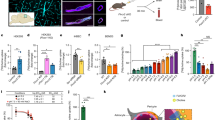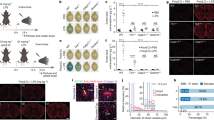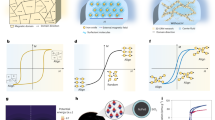Abstract
For patients with drug-resistant focal epilepsy, excision of the epileptogenic zone is the most effective treatment approach. However, the surgery is less effective in the 15–30% of patients whose lesions are not distinct when visualized by magnetic resonance imaging (MRI). Here, we show that an intravenously administered MRI contrast agent consisting of a paramagnetic polymer coating encapsulating a superparamagnetic cluster of ultrasmall superparamagnetic iron oxide crosses the blood–brain barrier and improves lesion visualization with high sensitivity and target-to-background ratio. In kainic-acid-induced mouse models of drug-resistant focal epilepsy, electric-field changes in the brain associated with seizures trigger breakdown of the contrast agent, restoring the T1-weighted magnetic resonance signal, which otherwise remains quenched due to the distance-dependent magnetic resonance tuning effect between the cluster and the coating. The electric-field-responsive contrast agent may increase the probability of detecting seizure foci in patients and facilitate the study of brain diseases associated with epilepsy.
This is a preview of subscription content, access via your institution
Access options
Access Nature and 54 other Nature Portfolio journals
Get Nature+, our best-value online-access subscription
$29.99 / 30 days
cancel any time
Subscribe to this journal
Receive 12 digital issues and online access to articles
$99.00 per year
only $8.25 per issue
Buy this article
- Purchase on Springer Link
- Instant access to full article PDF
Prices may be subject to local taxes which are calculated during checkout







Similar content being viewed by others
Data availability
The main data supporting the results in this study are available within the paper and its Supplementary Information. The raw and analysed datasets generated during the study are too large to be publicly shared, yet they are available for research purposes from the corresponding authors on reasonable request. The availability of raw patient data is subject to approval from the Institutional Review Board of Huashan Hospital.
Code availability
The raw MATLAB codes are available in the Supplementary Information.
References
Vattoth, S., Manzil, F. F. P., Singhal, A., Riley, K. O. & Bag, A. K. State of the art epilepsy imaging an update. Clin. Nucl. Med. 39, 511–526 (2014).
Thurman, D. J. et al. Standards for epidemiologic studies and surveillance of epilepsy. Epilepsia 52, 2–26 (2011).
Loscher, W., Klitgaard, H., Twyman, R. E. & Schmidt, D. New avenues for anti-epileptic drug discovery and development. Nat. Rev. Drug Discov. 12, 757–776 (2013).
Kwan, P. & Brodie, M. J. Early identification of refractory epilepsy. N. Engl. J. Med. 342, 314–319 (2000).
Kwan, P., Schachter, S. C. & Brodie, M. J. Drug-resistant epilepsy. N. Engl. J. Med. 365, 919–926 (2011).
Luders, H. O., Najm, I., Nair, D., Widdess-Walsh, P. & Bingman, W. The epileptogenic zone: general principles. Epileptic Disord. 8, S1–S9 (2006).
Olson, L. D. & Perry, M. S. Localization of epileptic foci using multimodality neuroimaging. Int. J. Neural Syst. 23, 1230001 (2013).
Zhang, J. et al. Multimodal neuroimaging in presurgical evaluation of drug-resistant epilepsy. Neuroimage Clin. 4, 35–44 (2014).
Duncan, J. S., Winston, G. P., Koepp, M. J. & Ourselin, S. Brain imaging in the assessment for epilepsy surgery. Lancet Neurol. 15, 420–433 (2016).
Siegel, A. M. et al. Medically intractable, localization-related epilepsy with normal MRI: presurgical evaluation and surgical outcome in 43 patients. Epilepsia 42, 883–888 (2001).
Téllez-Zenteno, J. F., Ronquillo, L. H., Moien-Afshari, F. & Wiebe, S. Surgical outcomes in lesional and non-lesional epilepsy: a systematic review and meta-analysis. Epilepsy Res. 89, 310–318 (2010).
Davis, K. A. et al. Glutamate imaging (GluCEST) lateralizes epileptic foci in nonlesional temporal lobe epilepsy. Sci. Transl. Med. 7, 309ra161 (2015).
Gao, X. et al. Guiding brain-tumor surgery via blood–brain-barrier-permeable gold nanoprobes with acid-triggered MRI/SERRS signals. Adv. Mater. 29, 1603917 (2017).
Catanzaro, V. et al. A R2p/R1p ratiometric procedure to assess matrix metalloproteinase-2 activity by magnetic resonance imaging. Angew. Chem. Int. Ed. 52, 3926–3930 (2013).
Moussaron, A. et al. Ultrasmall nanoplatforms as calcium-responsive contrast agents for magnetic resonance imaging. Small 11, 4900–4909 (2015).
Chen, Q. et al. H2O2-responsive liposomal nanoprobe for photoacoustic inflammation imaging and tumor theranostics via in vivo chromogenic assay. Proc. Natl Acad. Sci. USA 114, 5343–5348 (2017).
Angelovski, G. Heading toward macromolecular and nanosized bioresponsive MRI probes for successful functional imaging. Acc. Chem. Res. 50, 2215–2224 (2017).
Ying, X. et al. Angiopep-conjugated electro-responsive hydrogel nanoparticles: therapeutic potential for epilepsy. Angew. Chem. Int. Ed. 53, 12436–12440 (2014).
Yan, Q. et al. Voltage-responsive vesicles based on orthogonal assembly of two homopolymers. J. Am. Chem. Soc. 132, 9268–9270 (2010).
Shin, T.-H. et al. T1 and T2 dual-mode MRI contrast agent for enhancing accuracy by engineered nanomaterials. ACS Nano 8, 3393–3401 (2014).
Lee, N. et al. Iron oxide based nanoparticles for multimodal imaging and magnetoresponsive therapy. Chem. Rev. 115, 10637–10689 (2015).
Santra, S. et al. Gadolinium-encapsulating iron oxide nanoprobe as activatable NMR/MRI contrast agent. ACS Nano 6, 7281–7294 (2012).
Choi, J. S. et al. Distance-dependent magnetic resonance tuning as a versatile MRI sensing platform for biological targets. Nat. Mater. 16, 537–542 (2017).
Demeule, M. et al. Involvement of the low-density lipoprotein receptor-related protein in the transcytosis of the brain delivery vector angiopep-2. J. Neurochem. 106, 1534–1544 (2008).
Feng, A., Yan, Q., Zhang, H., Peng, L. & Yuan, J. Electrochemical redox responsive polymeric micelles formed from amphiphilic supramolecular brushes. Chem. Commun. 50, 4740–4742 (2014).
Gouder, N., Fritschy, J. M. & Boison, D. Seizure suppression by adenosine A1 receptor activation in a mouse model of pharmacoresistant epilepsy. Epilepsia 44, 877–885 (2003).
Guo, Y. et al. In vivo mapping of temporospatial changes in glucose utilization in rat brain during epileptogenesis: an 18F-fluorodeoxyglucose-small animal positron emission tomography study. Neuroscience 162, 972–979 (2009).
van Vliet, E. A., Dedeurwaerdere, S. & Cole, A. J. WONOEP appraisal: imaging biomarkers in epilepsy. Epilepsia 58, 315–330 (2017).
Levesque, M. & Avoli, M. The kainic acid model of temporal lobe epilepsy. Neurosci. Biobehav. Rev. 37, 2887–2899 (2013).
Riban, V. et al. Evolution of hippocampal epileptic activity during the development of hippocampal sclerosis in a mouse model of temporal lobe epilepsy. Neuroscience 112, 101–111 (2002).
Racine, R. J. Modification of seizure activity by electrical stimulation: II. Motor seizure. Electroencephalogr. Clin. Neurophysiol. 32, 281–294 (1972).
Balosso, S. et al. A novel non-transcriptional pathway mediates the proconvulsive effects of interleukin-1β. Brain 131, 3256–3265 (2008).
Maroso, M. et al. Toll-like receptor 4 and high-mobility group box-1 are involved in ictogenesis and can be targeted to reduce seizures. Nat. Med. 16, 413–419 (2010).
Acknowledgements
We thank M. Kuang, R. Liang, L. Zhan and X. Liu for experimental help. We thank X. Zhu for help with statistical analysis. We also thank L. Zhou, M. Gao and S. Jiang for useful discussions. This work was supported by the National Natural Science Foundation of China (grant no. 81771895, 81971598, 81725009 and 81501120), the Shanghai Foundation for Development of Science and Technology (grant no. 19431900400), the Shanghai Municipal Science and Technology Major Project (grant no. 2018SHZDZX01), the Fudan-SIMM Joint Research Fund (grant no. 20173001), the Asia 3 Foresight Program (grant no. 81761148029), the Shanghai Shuguang Program (grant no. 19SG06) and the Shanghai Municipal Commission of Health and Family Planning (grant no. 2017BR003).
Author information
Authors and Affiliations
Contributions
C.W., H.Z., M.T., Y.M. and C.L. conceived and designed the research. C.W., W.S., Jianping Zhang, Q.G., X.Z., H.L., M.Q., D.F., X.G., H.X. and J.W. performed the experiments. Z.W. and Y.M. provided clinical patient specimens. C.W., W.S., Jun Zhang, Z.G., J.W., Z.W. and C.L. analysed and interpreted the results. C.W., N.J.L. and C.L. wrote the manuscript. C.L. supervised the overall project.
Corresponding authors
Ethics declarations
Competing interests
The authors declare no competing interests.
Additional information
Publisher’s note Springer Nature remains neutral with regard to jurisdictional claims in published maps and institutional affiliations.
Supplementary information
Supplementary Information
Supplementary methods, figures, tables and references.
MATLAB code
Code for the processing of mouse magnetic-resonance images.
Supplementary Video 1
Monitoring of typical seizure behaviours in mice.
Rights and permissions
About this article
Cite this article
Wang, C., Sun, W., Zhang, J. et al. An electric-field-responsive paramagnetic contrast agent enhances the visualization of epileptic foci in mouse models of drug-resistant epilepsy. Nat Biomed Eng 5, 278–289 (2021). https://doi.org/10.1038/s41551-020-00618-4
Received:
Accepted:
Published:
Issue Date:
DOI: https://doi.org/10.1038/s41551-020-00618-4
This article is cited by
-
Advances in magnetic nanoparticle-based magnetic resonance imaging contrast agents
Nano Research (2023)
-
In vivo three-dimensional multispectral photoacoustic imaging of dual enzyme-driven cyclic cascade reaction for tumor catalytic therapy
Nature Communications (2022)
-
Nanotechnology-based approaches in diagnosis and treatment of epilepsy
Journal of Nanoparticle Research (2022)
-
Electric boost of MRI contrast for epileptic foci
Nature Biomedical Engineering (2021)



